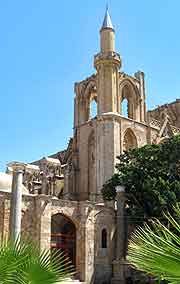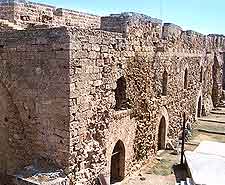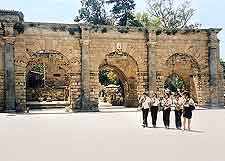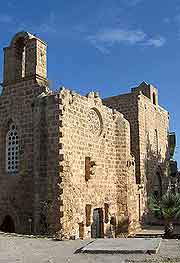Famagusta History Facts and Timeline
(Famagusta, Cyprus)

The history of Famagusta is somewhat varied. A very Turkish resort town today, it was initially built up by the French Lusignan clan and later became home to the Venetians, Ottoman Turks and British. Famagusta has flourished since independence as a tourist resort and port. Despite heavy fighting over the centuries, the town has managed to retain some worthwhile historic attractions.
King Ptolemy is said to have been the man responsible for founding this city shortly after the turn of the 3rd century BC, building directly over ancient Arsinoe. After the nearby Roman settlement of Salamis declined, Famagusta expanded from a small fishing village and became a port town, growing steadily through the early Middle Ages.
Wealth and the Middle Ages
Despite this, Famagusta didn't even reach village status until Lusignan rule was established in the late 12th century. The combination of its natural harbour and old town walls led to an increase of its population and trade status. Following the influx of Christian merchants fleeing from Palestine a century later, Famagusta grew to become a significant trading port.

The Lusignan clan strengthened the town's defences, including the building of Othello's Tower (the Citadel) located on the corner of the city's Venetian walls, marking a critical period in Famagusta's history. The Lusignans also had a palace and cathedral built - the 14th-century Cathedral of St. Nicholas. With the influx of religious folk to the town, it was soon an important stop-off to
Israel and came to be known as the 'district of churches'.
The Genoese and Venetians also influenced Famagusta history, with much rivalry between merchants, including the Genoese occupation and eventual sacking of parts of the island. The Venetians then decreed that Famagusta would be their island capital, replacing
Nicosia, and subsequently improved the town's defences. Today, these defence structures are among the best kept Venetian fortifications in this part of the Mediterranean and tourists can walk freely along them.

Ottoman Turks
Famagusta eventually came under siege by the Ottoman Turks in the year of 1570, and by the end of the year, all of
Cyprus was under Turkish control. The Turks turned the Cathedral of St. Nicholas into the Lala Mustafa Pasha Mosque, and also developed the marketplace and built the Old Kirtikli Bathhouse, amongst other improvements. Yet, nevertheless, the city declined under the Ottoman rule. The walls eventually crumbled and Christians were mostly banished.
Greek Cypriots settled in one quarter of Famagusta known as Varosha. Eventually the British came on the scene in 1878 and harmonised the region somewhat, developing both the harbour and the town. Later, they also set up camps for Jewish Holocaust survivors.

Independence and UN Buffer Zone
Independence for Cyprus came in 1960 and Famagusta flourished as a tourist destination for the wealthy. Visitors came for its beaches and historic sites, and all was well until the re-invasion of Cyprus by the Turkish in 1974. Turkish Cypriots hid out within the old town walls from the surrounding Greek villages, but were eventually relieved by Turkish forces.
The history of Famagusta caused it to be placed to the north of the UN buffer zone. It slowly managed to bounce back from its earlier decline and is today a major destination that side of the divide. The New Town and tourist resorts reside to the south of the walled city (Gazimagusa), which is home to the Statue of Ataturk.
 The history of Famagusta is somewhat varied. A very Turkish resort town today, it was initially built up by the French Lusignan clan and later became home to the Venetians, Ottoman Turks and British. Famagusta has flourished since independence as a tourist resort and port. Despite heavy fighting over the centuries, the town has managed to retain some worthwhile historic attractions.
The history of Famagusta is somewhat varied. A very Turkish resort town today, it was initially built up by the French Lusignan clan and later became home to the Venetians, Ottoman Turks and British. Famagusta has flourished since independence as a tourist resort and port. Despite heavy fighting over the centuries, the town has managed to retain some worthwhile historic attractions. The Lusignan clan strengthened the town's defences, including the building of Othello's Tower (the Citadel) located on the corner of the city's Venetian walls, marking a critical period in Famagusta's history. The Lusignans also had a palace and cathedral built - the 14th-century Cathedral of St. Nicholas. With the influx of religious folk to the town, it was soon an important stop-off to Israel and came to be known as the 'district of churches'.
The Lusignan clan strengthened the town's defences, including the building of Othello's Tower (the Citadel) located on the corner of the city's Venetian walls, marking a critical period in Famagusta's history. The Lusignans also had a palace and cathedral built - the 14th-century Cathedral of St. Nicholas. With the influx of religious folk to the town, it was soon an important stop-off to Israel and came to be known as the 'district of churches'.
